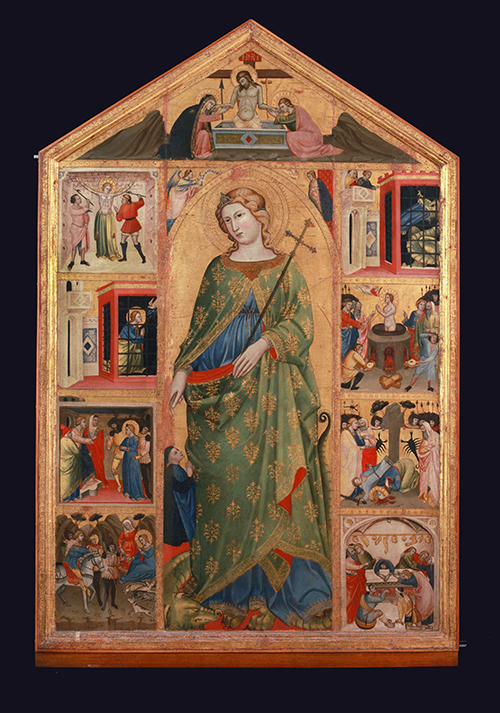> OUR PROJECTS > SAINT MARGARET OF ANTIOCH AND STORIES OF HER LIFE
SAINT MARGARET OF ANTIOCH AND STORIES OF HER LIFE
October 2020
Painted on a large vertical ogival panel which recalls the shape of a tabernacle, and framed by a Gothic arch, a young Saint Margaret of Antioch, also known by the name of Saint Marina, stands like a column statue, proud and magnificent. Draped in a precious cloak of green damask embroidered with a motif of gold palmettes, a diadem placed on her golden hair, in one hand she holds a slim Crucifix, while with the other she welcomes the figure on her right, the kneeling donor, who is smaller in scale. At her feet lies the conquered dragon, symbolising evil and related to an episode from her life. According to the hagiographers, the dragon devoured the saint who saved herself by slashing its belly open with her Crucifix. The tradition of this extraordinary event gave Margaret the ability to grant wishes to those who invoke her.

Painted in the manner of Turino Vanni.
SAINT MARGARET OF ANTIOCH AND STORIES OF HER LIFE, CIRCA 1400.
Gold leaf and tempera on an ogival poplar panel
Gold leaf and tempera
166x106.7 cm
MV 40007
In the ogival part of the panel, between the Virgin Mary and Saint John the Evangelist is depicted the Vir Dolorum, and below, in the spandrels adjacent to the Gothic arch, are painted two small figures: the announcing Angel and the announced Virgin.
On either side of the Saint are depicted four scenes from her life, starting from the one in the lower left-hand side and ending with the painting on the lower right-hand side.
The Legend of Saint Margaret has been passed down by a Greek Passio that narrates the story of a girl born in 275 A.D. in Antioch, modern-day Turkey. She was the daughter of a pagan priest at the time when the apostles Barnaby and Paul were spreading the joyous message of the coming of Jesus Christ our Saviour.
Margaret had been brought up by a wetnurse who had secretly introduced her to Christianity and at the tender age of 15 she was martyred as a witness of her faith.
The origin of the panel painting is unknown; it was transferred from the Sacred Museum of the Vatican Library to the Pinacoteca, the Vatican Art Gallery, in 1908.
The painting dates back to around the 15th century and was initially attributed to the Tuscan school; however, its style was later likened to that of the painter Turino Vanni (b. Rigoli, Pisa , 1349 d. after 1438) who was active in Pisa and Genoa.
The type of hagiographic panel, albeit with various forms, became common in Tuscany in the early 15th century, with the purpose of celebrating cities through the glorification of their patron saints.
List of stories (from the lower left-hand side to the lower right-hand side)
In the first scene, the governor Olibrio meets Margaret in the fields and is struck by her beauty.
In the second scene, the girl is standing in front of the governor refusing to marry him.
In the third scene, Margaret, who has been imprisoned, is comforted by a dove.
In the third scene, the girl is brutally scourged.
The story continues on the other side: in the first scene Margaret is imprisoned, once again, and is attacked by the Dragon.
In the second scene, the girl is plunged into boiling liquid but miraculously remains unharmed.
In the third scene, the Saint is beheaded and her executioner dies instantly.
In the final scene, the sick and the crippled gather around the Saint’s tomb, to give thanks.
by Adele Breda
The Italian & International Patrons of the Arts in the Vatican Museums wish to thank Olessia Kantor, Amy Gallant Sullivan & Sabrina Zappia for supporting this project.
|